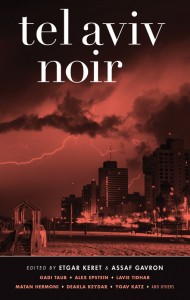Boris Kurbanov, Jewish Sound Correspondent
It’s a noir world, or so the publishers at Akashic Books would have us think.
Ever since the release of 2004’s best-selling “Brooklyn Noir,” the editors at the Brooklyn-based independent publisher have taken to traversing the globe, soliciting seamy and sometimes downright malicious tales from Paris, Mumbai, Los Angeles, Moscow, Haiti, Singapore, and more recently, Tehran. For its Tel Aviv treatment, editors Etgar Keret and Assaf Gavron give us a closer look at the White City — the high-tech and cultural hub of the country renowned for its urban beach life, art, food, fashion and nightlife.
But as with many of the world’s exotic destinations, the city has its dark secrets and sinister goings-on, too, complete with people you wouldn’t want to meet for lunch in a bustling restaurant on Dizengoff, much less in a dark alley behind King George Street.
These secrets are explored in “Tel Aviv Noir,” the newest offering in a crime anthology which probes — through 14 short fiction stories tinged with mystery — the dark side of the always-thriving, 24-hour metropolis while evoking the neuroses, tension and paranoia with which Tel Avivians are all too familiar. Each story takes place in a neighborhood you know well, from Dizengoff and Florentin to Rabin Square, Levinsky Park and a lobby of a plush hotel on HaYarkon.
Tel Aviv, known as Israel’s financial and commerce seat, doesn’t often conjure up thoughts of criminal activity and general anti-social behavior. Yet this collection underscores just that, showing us that even the sunniest of places have their dark corners and evils.
“In spite of its outwardly warm and polite exterior, Tel Aviv has quite a bit to hide,” writes Keret, who himself writes short stories that remind us how complicated it is to be human. As he observes in the introduction, the concept of noir in Tel Aviv may not be immediately clear to readers, because the city is renowned for being “one of the happiest, friendliest, most liberal cities in the world…what could possibly be dark about our sunny city?”
Plenty, as it turns out. The stories in “Tel Aviv Noir” are divided into three categories: Encounter, estrangements and corpses. Keret and Gavron begin with the light stuff and save the bodies and body parts for the end.
Each story includes different slices of life in Israel. There’s a murder mystery at a startup in Dizengoff Square, a woman who becomes a prostitute to pay off her father’s debts, a couple that adopts a dog with unusual eating habits and violent tendencies, a pregnant Palestinian woman who suffers a miscarriage due to a delay at a checkpoint, and ominous visits from the Shin Bet.
Most stories in “Noir” are compelling page-turners, though some are swing-and-misses. All, however, give us a better look at what it means to live in the city known to outsiders as “the Bubble.”
“Don’t get me wrong—Tel Aviv is a lovely, safe city,” Keret concedes. “Most of the time, for most of its inhabitants. But the stories [in the book] describe what happens the rest of the time, to the rest of its inhabitants.” The tales expose, in his words, “the concealed, scarred face of this city that we love so much.”
For each new book in the series a key decision is finding the right editors — those who bring together writers across divides of religion, ethnicity and politics. For “Noir,” Keret and Gavron set out to introduce some of Israel’s top contemporary writers to English-speaking audiences, hoping to catapult their careers and get them published abroad while painting a stark picture about what takes place after dark, letting the vignettes play out against a big, flashy, dangerous Tel Aviv backdrop, full of schemers and undesirables, reminding us most sunny getaways aren’t always what they seem.
A “Jerusalem Noir” is in the works.